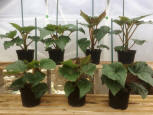Episode 10 –
mid June
Shrewsbury
plants
I have just started securing buds and stopping the plants. It’s just a
personal thing but I try to think of this as two separate operations
●
Stopping the
plant – the removal of the growing point just above the bud. There are
two schools of thought here – to leave one leaf on above the bud to help
to draw nutrients up to the bud or to remove all of the leaves above the
bud. I prefer the latter because I think the bud straightens up quicker
that way and when I have tried leaving one leaf above the bud, I end up
removing it anyway because it gets in the way when it comes to putting
the collar on.
●
Securing the
bud – removing all buds except the one chosen to flower and the removal
of the calyx, which is the outer covering of the chosen bud and the two
smaller buds that are at the side of the flowering bud. The calyx will
restrict the way the bud opens and we only require the central bud.
All of those
that are secured have had their first feed – due to the expected hot
weather they had a half strength feed of balanced Vitax liquid rather
than one with higher potash and a few of the remainder that will be
secured by the 29th June also had the same feed as they
looked like they needed it. Bud securing can be frustrating as you can
only secure the bud closest to the size you need but this Tequila
Sunrise was annoying – the size was just about right but I really
don’t want a bud with three guard petals – see below left – the bloom
might have ended up looking like Napoleon’s hat! Luckily I still had the
lower bud on so took that, but it is about a week earlier so already I
have one bloom that will possibly go over before the show! Other than
that, the rest of the earlier secured plants are progressing well – see
Tom Brownlee below centre and Tequila Sunrise below right



Dundee plants
These have always looked at least three weeks behind the Shrewsbury
plants but the way things have worked out, the majority of the
Shrewsbury plants are adult tubers whereas the majority of the Dundee
plants are cutting tubers or cuttings so the plants they produce may not
be quite as bulky as ones grown from an adult tuber, so this may have
exaggerated the difference. However, over the last few days, the Dundee
plants have filled out a bit and will need to be watched closely for
signs of running out of fertilizer between now and bud securing time. I
think that the signs are almost there now, particularly with those
stronger growing varieties that are only in a 3 litre pot – see Sweet
Dreams below

Flowering
cuttings
It’s amazing how vigorous these plants are, especially once the roots
move into the compost of the final pots and they still have three weeks
growing to do before bud securing – see clockwise from top left –
Nichola Coates, Alexandra, Symestar, Daisy Trinder, Lindsey Smith, Colin
Hamilton and Tigger, below left. Some have caught up to some
of the cutting tubers that the cuttings may even have been taken from –
see Symestar below right – the cutting is on the left, cutting
tuber on the right. There will be a logical reason for this speedy
growth but I don’t have a firm idea of what it is, just an untidy jumble
of thoughts that need sorting out – I will leave that tricky job until
I’m sitting with a beer or three in the sun in Spain later in the year!
I didn’t think
that I would have any of the cuttings advanced enough for Shrewsbury but
a few have just about made it and as they are 42 day varieties I will
wait until that date to make my final decision whether to flower them
for Shrewsbury or a later show.


Stock cuttings
The majority of these are in their final one litre pots, all of the
later ones will go into a smaller pot as I don’t think that the plants
fully concentrate their efforts on tuber production until the roots have
ran out of compost so if I use a 1 litre pot it will take longer to get
to that point. Quite a few of those in 1 litre pots are now at my Mam’s
house under the carport where they will stay until September when space
becomes available in the greenhouses again.
The cuttings
cannot be forgotten about once potted up. I check each plant at least a
couple of times a week for new growth because once they have been
stopped at four leaves, they will keep producing growth from wherever
they can. Any new basal shoots need to be carefully removed as close to
compost level as possible but no lower as I don’t want to damage the new
tuber. Any growths from the leaf axils are removed completely. Once the
pots are full of roots they will also need a half strength balanced feed
every week or two.
If anyone has
never tried rooting a leaf or has doubts about it I would give it a go.
It is especially useful when you have limited stock of a variety but I
wouldn’t leave it too late in the season as it does take a while to
produce new basal growths but it does work! – see Anniversary
after six weeks below right. I can even see a time when with a bit more
experience and confidence in the method that this becomes as popular a
method for tuber production as taking standard cuttings.

Summer jobs
Once final potting is completed, for both those plants to be flowered or
the cuttings growing on for stock, the routine settles down and allows
plenty of time to keep well on top of everything.
I don’t put the sticks into the final pots straight away because I like
to wait until the plants have decided which way they want to face. The
stick needs to go 180 degrees from the direction the leaves are pointing
and I find if I do this straight away, I usually have to adjust them
later on so I wait for around three weeks by which time the growth has
settled down. Some varieties are worse than other – Tom Brownlee,
Tequila Sunrise, Tigger, Ruby Young and Alana Hamilton often
can’t make their mind up until the middle of June for me – see Alana
Hamilton below.

Additionally,
once the compost has settled through watering, the stick goes in firmly
and at around 3 weeks after potting I don’t think there will be any root
damage to speak of. Subsequent watering and root growth will ensure that
the stick doesn’t move come flowering time.
All plants have
their first ties in place – I use polypropylene florists tape that I
tear down into narrower strips, usually three - also I am very fussy
about the colour – it has to be Hunter Green – see below. My wife gets
this for me from a local florists warehouse and she thinks that I a
right pain in the proverbial and as usual, she is completely right!

Last year, I
had put the exterior shading on the greenhouses before the end of May
but his year I have managed to leave it until 23rd of June.
The two reasons for this are that the fleece that I line the inside of
the greenhouses with is fairly thick, but also the temperatures have
been quite a bit down on last year. Looking back, to last year, things
actually cooled down a bit through parts of June but May was so hot that
I had no choice but to use it, but this year I have managed without it
for a few weeks longer, however with much warmer weather forecast and
the buds to be flowered appearing I couldn’t have left it any later so I
picked a day when I was almost guaranteed dry weather and got started.
It’s amazing how effective it is in reducing the temperature but it also
reduces the light level and consequently I don’t think my plants are
generally quite as tall as they were last year but some of them are
still a bit too tall for my liking – see Burnout below

With regard to
mildew, prevention is infinitely better than cure so they have all been
sprayed with Fungus Clear Ultra but only at half strength as I find that
full strength is guaranteed to burn the foliage. I have also placed my
order for predators for begonia mite to ensure they are out on patrol in
good time for the buds opening.
The ‘F’ word!
Over the course of 12 months, I probably split my hobby time 50/50
between begonias and photography. Now it’s great when people say that
they like my work but I have to say that I am bemused when they say
’that’s a nice photograph, you must have a good camera’ and it is just
as illogical as saying ‘they are nice flowers, what do you feed them
on?’ The only answer to this is that feeding is just a small part of
cultivation and if and when I do feed, I give them only what they need,
when they need it – nothing more and nothing less.
I stopped
overhead sprays of Maxicrop around the beginning of June once the plants
were taking hold of the compost in the final pots and as I mentioned
earlier, now is the time to watch them very carefully for signs of
hunger. The main tell tale signs for me are:
●
Slight
lightening of the foliage colour – this will become more yellow as the
condition progresses
●
Reduced vigour in the growing tip
●
More than six weeks since final potting – I had this vision when I
retired that my plant labels would have details of every stage of the
plants growth through the season but in reality they only have the three
most important bits of information about the plant – the name, the age
and the date of final potting – without this date, it’s impossible to
tell how long the plant has been in it’s final pot
The
plants should not require any supplementary feeds for approaching 6
weeks. After that, if the bud is secured all I give them is an absolute
maximum of one full strength feed per week of a liquid feed that is
slightly higher in potash, unless it’s really warm when it would be a
balanced feed, with a final feed at least a week before bloom maturity
that is high in potash and low in nitrogen. I use liquid because if
solid feeds are used, they are not readily available to the plant so
there is a delayed reaction, and because they need to be watered in
order for them to be activated, their use can compromise the watering
regime. I never feed a dry plant as much of the feed will be lost due to
run through and I also try to be accurate with the amount of feed I give
them. Any plants that look like they need a feed before the bud is
secured get a half strength feed of a balanced liquid feed.
Gardening Scotland
As promised, here is the SBS Silver Medal stand at Gardening Scotland,
Ingleston earlier this month – photo courtesy of Peter Matthews, SBS
Secretary

What’s keeping me awake at
night?
Certainly not the World Cup – come on, it’s only six weeks to Shrewsbury
– what else?
Next
episode – managing the buds for flowering.